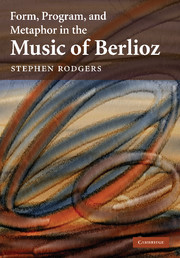Book contents
- Frontmatter
- Contents
- Music examples
- Figures
- Acknowledgments
- 1 Introduction
- 2 Preliminary examples and recent theories
- 3 Form as metaphor
- 4 Mixing genres, mixing forms: sonata and song in Le Carnaval romain
- 5 The vague des passions, monomania, and the first movement of the Symphonie fantastique
- 6 Love's emergence and fulfillment: the Scène d'amour from Roméo et Juliette
- 7 Epilogue
- Notes
- Bibliography
- Index
6 - Love's emergence and fulfillment: the Scène d'amour from Roméo et Juliette
Published online by Cambridge University Press: 27 June 2009
- Frontmatter
- Contents
- Music examples
- Figures
- Acknowledgments
- 1 Introduction
- 2 Preliminary examples and recent theories
- 3 Form as metaphor
- 4 Mixing genres, mixing forms: sonata and song in Le Carnaval romain
- 5 The vague des passions, monomania, and the first movement of the Symphonie fantastique
- 6 Love's emergence and fulfillment: the Scène d'amour from Roméo et Juliette
- 7 Epilogue
- Notes
- Bibliography
- Index
Summary
Looking for Shakespeare in Berlioz
I return to the preface to Roméo et Juliette, cited in chapter 2, in which Berlioz explains why he set the dialogue of Shakespeare's garden and cemetery scenes for instruments rather than for voices. Since plenty of vocal “duets of love and despair” had already been written, he thought it
wise as well as unusual to attempt another means of expression. It is also because the very sublimity of this love made its depiction so dangerous for the musician that he had to give his imagination a latitude that the positive sense of the sung words would not have given him, resorting instead to instrumental language, which is richer, more varied, less precise, and by its very indefiniteness incomparably more powerful in such a case.
This passage has been quoted often in the Berlioz literature. It stands as nothing short of a credo that sums up Berlioz's convictions about the expressive capabilities of instrumental music – a credo that we have seen expressed in similar ways in a variety of places. Yet for all its force and clarity, it has made it no easier to disentangle the threads that bind the movements alluded to above, the Scène d'amour and Roméo au tombeau des Capulets, to the dramatic scenes that inspired them. From the premiere of the work in 1839 to the present day, listeners have wrestled with the question of where to look for Shakespeare in Berlioz's score, if at all.
- Type
- Chapter
- Information
- Form, Program, and Metaphor in the Music of Berlioz , pp. 107 - 134Publisher: Cambridge University PressPrint publication year: 2009



